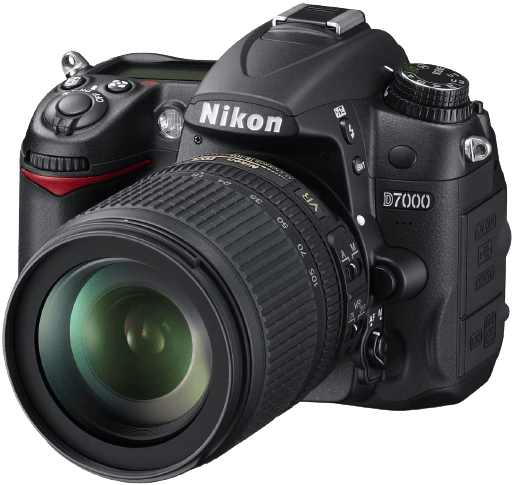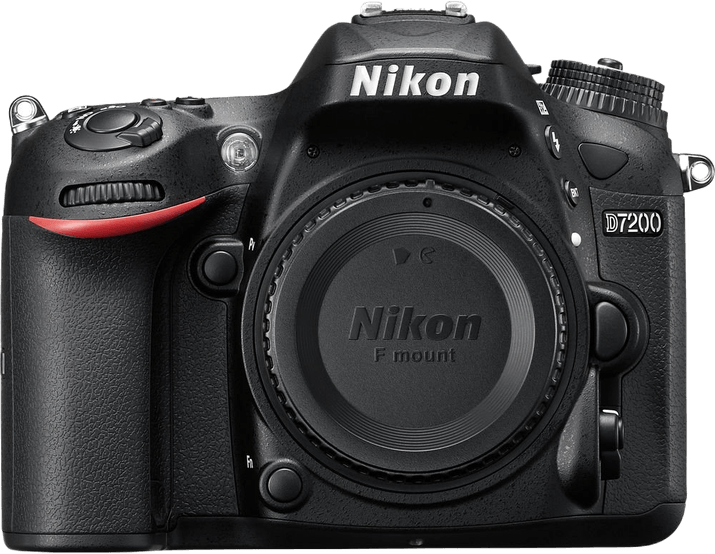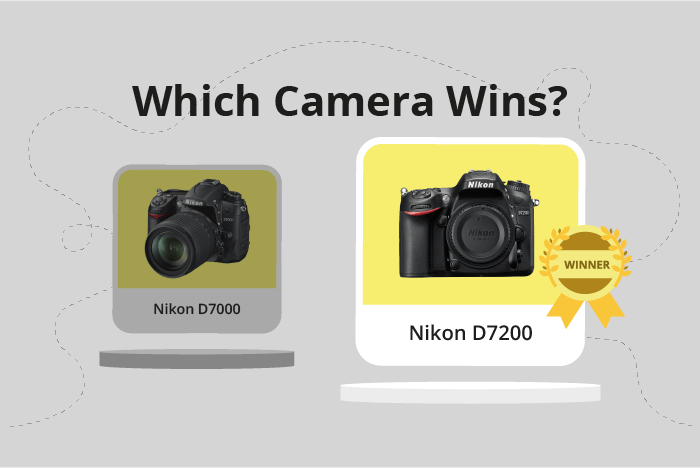Nikon D7000 vs D7200 Comparison
Nikon D7000

Nikon D7200

The Nikon D7200 emerges as the winner with a score of 68/100, while the Nikon D7000 trails behind at 56/100. The Nikon D7200 outperforms the D7000 with a marginally smaller and lighter body, measuring 136 x 107 x 76mm and weighing 765g. On the other hand, the D7000 is slightly bulkier at 132 x 105 x 77mm and heavier at 780g.
Being an older model, the Nikon D7000 does not offer any significant advantages over the D7200. The newer Nikon D7200 clearly has the edge in terms of specifications and performance, making it the better choice for photographers who want a more advanced and user-friendly camera.
Nikon D7000 vs D7200 Overview and Optics
The Nikon D7200 emerges as the winner in the optics comparison, with a score of 71/100, while the Nikon D7000 scores 55/100. Both cameras share several specifications, such as a CMOS sensor, an APS-C sensor size, a Nikon F lens mount, a shooting speed of 6 frames per second, and the absence of image stabilization.
The D7200 outperforms the D7000 in several aspects. It boasts 24.2 megapixels, compared to the D7000’s 16.2 megapixels, which results in higher resolution images. Additionally, the D7200 is equipped with the Expeed 4 processor, an upgrade from the D7000’s Expeed 2 processor. This allows for improved image processing and better overall performance. Furthermore, the D7200 has a higher DXOMARK sensor score of 87, compared to the D7000’s score of 80, indicating superior image quality and better low-light performance.
The D7000, on the other hand, does not have any significant advantages over the D7200 in terms of optics. Both cameras have the same shooting speed and lack image stabilization. The only difference lies in the lens mount, where the D7000 uses the Nikon F mount, and the D7200 utilizes the Nikon F DX mount. However, this difference does not impact the optical performance of the cameras.
The comparison reveals that the Nikon D7200 is the superior camera in terms of optics. Its higher megapixel count, advanced processor, and better sensor score contribute to its enhanced performance and image quality. While the Nikon D7000 shares some specifications with the D7200, it lacks any optical advantages, making the D7200 the clear choice for those seeking better image quality and performance.
Nikon D7000 vs D7200 Video Performance
The Nikon D7200 outperforms the Nikon D7000 in video capabilities with a 13-point higher score (70/100 for the D7200 and 57/100 for the D7000). Both cameras share some common specifications, such as Full HD (1920 x 1080) maximum video resolution and built-in time-lapse functionality. However, there are distinct differences that make the D7200 a better choice for video recording.
The most significant advantage of the Nikon D7200 is its higher maximum video frame rate, which reaches 60fps, compared to the D7000’s 24fps. This higher frame rate allows for smoother video playback and provides more flexibility when capturing fast-moving subjects or creating slow-motion effects in post-production. Consequently, the D7200 is better suited for sports, action, and wildlife videography.
Although the Nikon D7000 has a lower video score, it still possesses decent video capabilities for casual users or those who prioritize still photography. The Full HD video resolution and built-in time-lapse functionality are useful features for capturing everyday moments or creating artistic videos. However, the D7000 may not be the best choice for those who require advanced video features or higher frame rates.
To sum up, the Nikon D7200 is the clear winner in video capabilities due to its higher video score and 60fps maximum frame rate. This makes it a more versatile and suitable option for capturing fast-paced action or achieving professional-level video quality. On the other hand, the Nikon D7000 remains a viable option for casual videographers or those who prioritize still photography and do not require advanced video features.
Nikon D7000 vs D7200 Features and Benefits
The Nikon D7200 outperforms the Nikon D7000 in features, scoring 59/100 compared to the D7000’s 54/100. Both cameras share several specifications, including the absence of a touchscreen, flip screen, GPS, and Bluetooth. They both have built-in WIFI capabilities, allowing for easy sharing and transfer of photos.
The D7200 has the advantage with a larger screen size of 3.2 inches, compared to the D7000’s 3-inch screen. This larger display allows for better image review and menu navigation. Additionally, the D7200’s screen resolution is significantly higher at 1,228,800 dots, compared to the D7000’s 921,000 dots. This higher resolution results in sharper and more detailed image previews.
However, the D7000 does not necessarily fall short in all aspects. Despite its lower overall feature score, it still offers solid performance and capabilities for photographers. The fact that it shares many features with the D7200, such as WIFI and the lack of a touchscreen, flip screen, GPS, and Bluetooth, means that it remains a viable option for those who may not need the extra screen size and resolution offered by the D7200.
In comparing the Nikon D7000 and D7200, it is evident that the D7200 has the edge in terms of features, particularly with its larger and higher-resolution screen. However, the D7000 remains a capable camera with many shared specifications. Ultimately, photographers should consider their specific needs and preferences when choosing between these two models.
Nikon D7000 vs D7200 Storage and Battery
The Nikon D7200 and D7000 perform similarly in storage and battery. Both cameras accept SD, SDHC, and SDXC memory cards and use the EN-EL15 battery type. Both have dual memory card slots, allowing for more storage capacity and flexibility in file management. Neither camera offers USB charging.
The D7200 provides a longer battery life with 1110 shots compared to the D7000’s 1050 shots. This makes the D7200 a more reliable choice for extended shooting sessions.
The D7000, however, does not have any significant advantages in storage and battery over the D7200. Its only edge is the slightly lower price point, but this does not compensate for the lower performance in this category.
Nikon D7000 vs D7200 – Our Verdict
Are you still undecided about which camera is right for you? Have a look at these popular comparisons that feature the Nikon D7000 or the Nikon D7200:

